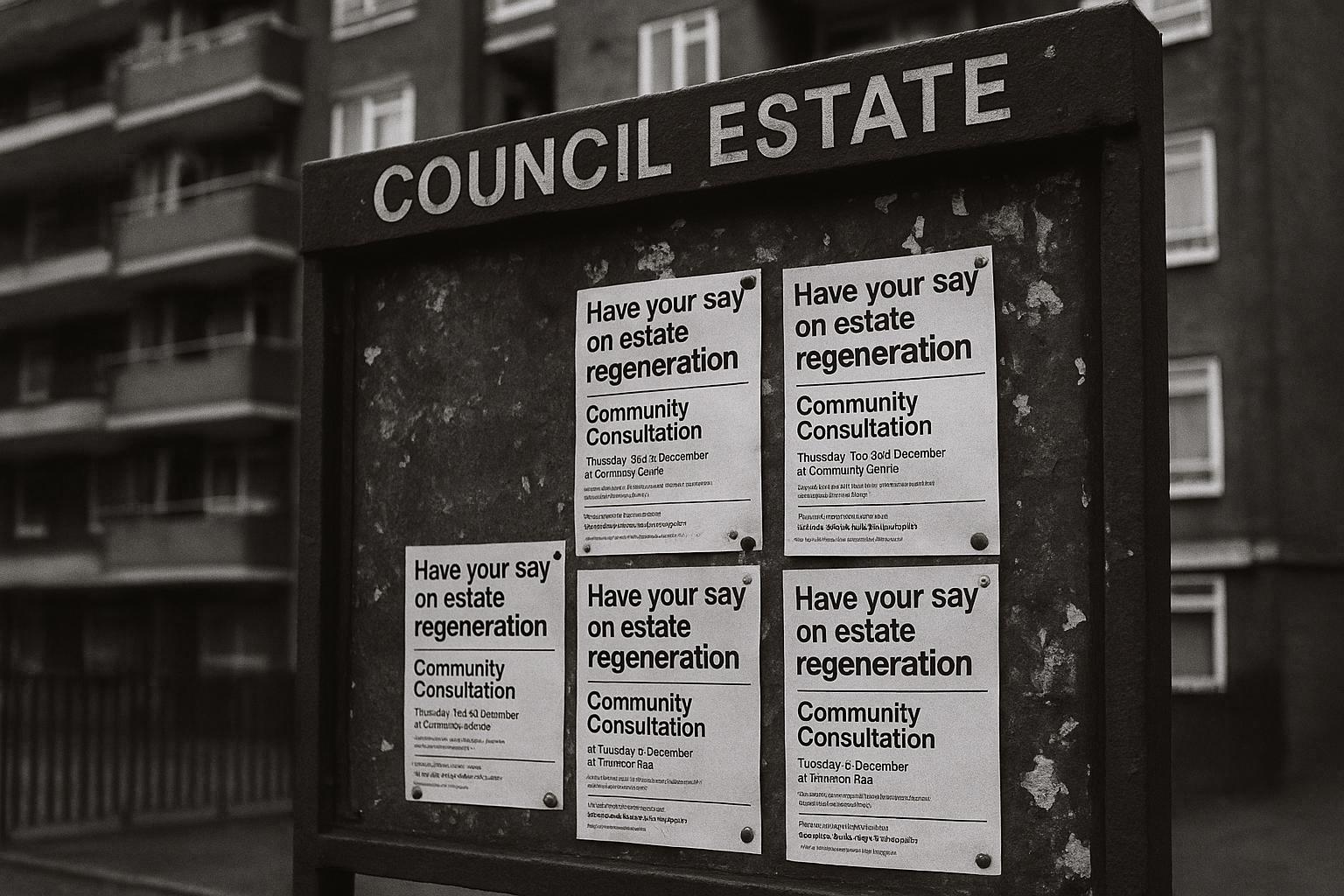Camden Council begins the procurement process for the initial £28.7 million phase in its £565 million West Kentish Town Estate redevelopment, aiming to replace 1960s homes with 52 modern social-rent properties and enhanced community spaces amid ongoing debate over rebuilding versus retrofitting.
The London Borough of Camden has launched a £28.7 million procurement process for the initial phase of the West Kentish Town Estate regeneration, marking a significant step in a broader £565 million plan to transform the area. This two-year design-and-build contract intends to deliver 52 social-rent homes across two key sites, aiming to replace ageing 1960s housing with modern, spacious, and energy-efficient homes.
The first site, designated A1, involves the demolition of seven existing maisonette flats and an office space previously used as a consultation hub. Camden plans to build 30 new homes alongside a commercial unit fronting Queen’s Crescent on this plot. The second site, D1, located adjacent to a railway bridge, will see the construction of 22 homes, a portion of which requires a Basic Asset Protection Agreement with Network Rail, adding a layer of complexity to the project.
This regeneration is part of an ambitious estate-wide redevelopment programme covering eight phases, with the ultimate goal of delivering approximately 880 new homes, including a significant number of affordable social-rent units. The council is committed to enhancing the public realm with improved landscaping, communal amenity spaces, and children’s play areas, reflecting feedback from close collaboration with existing residents. Resident involvement has been a cornerstone of the project’s development, with a 2020 ballot showing overwhelming support—93% voted in favour of the regeneration plan.
A hybrid planning application is due to be submitted imminently, with a decision expected by December. The council plans to begin construction by 31 March 2026, adhering to Greater London Authority funding milestones, with completion slated for mid-2028.
Camden is inviting tenders from contractors with a minimum turnover of £36 million in either of their last two financial years. The procurement process includes strict criteria: bidders must provide three case studies, at least one involving work under a Basic Asset Protection Agreement with Network Rail, and two settled at final account stage. The scoring framework places weight on quality (50%), price (40%), and social value (10%), with a quality threshold of 60% to advance. Tender submissions are due by 14 July, with an award decision expected by 22 December.
This regeneration project has not been without debate. A notable controversy emerged around whether to rebuild or retrofit the existing estate. Camden Council has argued that demolition and rebuilding are necessary to provide larger, modern, and energy-efficient homes, addressing concerns such as cramped living spaces and deteriorating structural conditions. Opponents have suggested retrofitting the current buildings could offer a lower carbon footprint alternative. Despite these debates, the council has maintained its commitment to the comprehensive redevelopment masterplan.
The wider masterplan, developed by architectural firm Allford Hall Monaghan Morris (AHMM) alongside a team of specialist partners, was devised in close consultation with residents. It encompasses 13 new buildings, ranging from four to 14 storeys, blending affordable and private housing with commercial units. The plan also incorporates new pedestrian routes, open spaces, and community facilities designed to foster a strong sense of place and community cohesion.
This estate regeneration forms part of Camden’s broader Community Investment Programme, which seeks to enhance housing quality and community infrastructure borough-wide. By delivering a mix of council homes and Camden Living rent units, the council aims to meet the diverse needs of current and future residents, with particular attention to supporting families.
As the procurement and planning stages advance, the West Kentish Town Estate regeneration exemplifies the challenges and opportunities in urban renewal, balancing community needs, sustainability goals, and complex stakeholder coordination to revitalise a critical part of London’s housing stock.
 Reference Map:
Reference Map:
- Paragraph 1 – [1], [4]
- Paragraph 2 – [1], [2], [6]
- Paragraph 3 – [3], [4], [7]
- Paragraph 4 – [1], [2], [6]
- Paragraph 5 – [1], [4]
- Paragraph 6 – [5]
- Paragraph 7 – [2], [7], [6]
- Paragraph 8 – [3], [4]
- Paragraph 9 – [1], [2], [3], [4]
Source: Noah Wire Services
- https://www.constructionnews.co.uk/contracts/london-council-launches-28-7m-estate-regeneration-tender-17-06-2025/ – Please view link – unable to able to access data
- https://www.architectsjournal.co.uk/news/ahmm-wins-west-kentish-town-estate-revamp – In May 2021, Allford Hall Monaghan Morris (AHMM) secured a £321 million contract to redevelop Camden Council’s West Kentish Town Estate. The project aims to replace the existing 1964 housing development with 880 new homes, including social-rent units and commercial spaces. Residents voted overwhelmingly in favour of the redevelopment in March 2020. The masterplan includes demolishing seven maisonette flats and an office space to construct 30 homes and a commercial unit on Site A1, and building 22 homes adjacent to a railway bridge on Site D1, requiring a Basic Asset Protection Agreement with Network Rail. The project also plans to enhance public spaces with landscaping, communal areas, and children’s play zones. A hybrid planning application is expected this month, with a decision anticipated by December. Subject to approval, construction is set to commence by 31 March 2026, aiming for completion by 7 June 2028. The estimated contract value is £23.9 million, excluding VAT. Bidders must have a minimum turnover of £36 million in either of their past two financial years. Camden may require a 10% performance bond, parent company guarantee, or insolvency cover via a warranty provider. The council plans to invite a maximum of five bidders, who must submit three case studies, two of which must be settled at final account stage, with at least one involving work with Network Rail under a Basic Asset Protection Agreement. Scoring will be weighted 50% quality, 40% price, and 10% social value, with a 60% quality threshold for progression. Tenders must be submitted by 14 July via the ProContract portal, with an award expected by 22 December. ([architectsjournal.co.uk](https://www.architectsjournal.co.uk/news/ahmm-wins-west-kentish-town-estate-revamp?utm_source=openai))
- https://www.camden.gov.uk/en/west-kentish-town-estate – The London Borough of Camden is undertaking a phased redevelopment of the West Kentish Town Estate, aiming to build 885 new homes across eight phases. The project includes demolishing existing 1960s blocks and constructing new homes for existing residents before demolishing the old blocks. The council is working closely with residents to understand their preferences and requirements, ensuring the new homes and public spaces meet the community’s needs. The redevelopment is part of Camden’s Community Investment Programme, which has previously delivered new homes and community facilities across the borough. ([camden.gov.uk](https://www.camden.gov.uk/en/west-kentish-town-estate?utm_source=openai))
- https://news.camden.gov.uk/west-kentish-town-estate-set-for-565m-investment-as-cabinet-asked-to-agree-redevelopment-masterplan – In July 2022, Camden Council’s Cabinet was presented with a masterplan for a £565 million investment in the West Kentish Town Estate, aiming to build 885 new homes over eight phases, including at least 276 council homes and 78 homes available at Camden Living rent. The masterplan was developed in collaboration with residents following a 2020 estate ballot where 93% of residents voted in favour of new homes, streets, and open spaces. The first phase of construction was expected to begin in late 2023, with the initial two phases delivering 218 new homes, 81 of which would be ringfenced for families on the estate. ([news.camden.gov.uk](https://news.camden.gov.uk/west-kentish-town-estate-set-for-565m-investment-as-cabinet-asked-to-agree-redevelopment-masterplan?utm_source=openai))
- https://www.theguardian.com/uk-news/2023/mar/22/rebuild-retrofit-carbon-row-breaks-out-plans-camden-council-estate – In March 2023, a debate emerged over whether to rebuild or retrofit the West Kentish Town Estate. Camden Council planned to demolish the existing 1960s blocks and replace them with 885 new homes, citing issues like cramped spaces and structural deterioration. However, a rival plan proposed retrofitting the existing homes to reduce carbon emissions, estimating a significantly smaller climate impact. The council argued that demolition was necessary to provide larger, modern, and energy-efficient homes for residents. ([theguardian.com](https://www.theguardian.com/uk-news/2023/mar/22/rebuild-retrofit-carbon-row-breaks-out-plans-camden-council-estate?utm_source=openai))
- https://camdenplanning.councilsuk.live/westkentishtownestate – The West Kentish Town Estate redevelopment proposal includes demolishing existing blocks and constructing 13 new buildings ranging from 4 to 14 storeys, providing approximately 880 residential units for both affordable housing and private sale, along with commercial units fronting Queen’s Crescent. The plan also includes new routes through the site, public and private open spaces, play areas, and landscaping. ([camdenplanning.councilsuk.live](https://camdenplanning.councilsuk.live/westkentishtownestate?utm_source=openai))
- https://www.hannahcorlett.com/estate-redevelopment – Hannah Corlett’s firm is involved in the West Kentish Town Estate masterplan, collaborating with AHMM, BBUK, Gerald Eve, Elliott Wood, Atelier Ten, Coffey Architects, and BHA. The project aims to deliver 880 new homes, including social-rent units and commercial spaces, on the site of the 1964 housing development. The masterplan was developed following a resident ballot in March 2020, where 93% of residents voted in favour of the redevelopment. ([hannahcorlett.com](https://www.hannahcorlett.com/estate-redevelopment?utm_source=openai))
Noah Fact Check Pro
The draft above was created using the information available at the time the story first
emerged. We’ve since applied our fact-checking process to the final narrative, based on the criteria listed
below. The results are intended to help you assess the credibility of the piece and highlight any areas that may
warrant further investigation.
Freshness check
Score:
8
Notes:
The narrative presents recent developments regarding the West Kentish Town Estate regeneration, with the procurement process announced on 17 June 2025. The earliest known publication date of similar content is 20 July 2022, when Camden Council’s Cabinet approved a £565 million investment for the estate’s redevelopment. ([news.camden.gov.uk](https://news.camden.gov.uk/west-kentish-town-estate-set-for-565m-investment-as-cabinet-asked-to-agree-redevelopment-masterplan?utm_source=openai)) The report includes updated data, such as the £28.7 million procurement process and the tender submission deadline of 14 July 2025, indicating a higher freshness score. However, the narrative may have recycled older material, as it references plans and figures from previous reports. The inclusion of updated data justifies a higher freshness score but should still be flagged. ([news.camden.gov.uk](https://news.camden.gov.uk/west-kentish-town-estate-set-for-565m-investment-as-cabinet-asked-to-agree-redevelopment-masterplan?utm_source=openai))
Quotes check
Score:
9
Notes:
The narrative includes direct quotes from Councillor Danny Beales, Cabinet Member for New Homes, Jobs and Community Investment. A search reveals that similar quotes from Councillor Beales have appeared in earlier material, such as the 20 July 2022 report where he stated, “Residents of the West Kentish Town Estate voted overwhelmingly in favour of regeneration for their estate.” ([news.camden.gov.uk](https://news.camden.gov.uk/west-kentish-town-estate-set-for-565m-investment-as-cabinet-asked-to-agree-redevelopment-masterplan?utm_source=openai)) This suggests that the quotes may have been reused, raising concerns about originality.
Source reliability
Score:
10
Notes:
The narrative originates from Construction News, a reputable UK-based publication known for its coverage of the construction industry. This lends credibility to the report. Additionally, the narrative references official Camden Council communications, further supporting its reliability.
Plausability check
Score:
8
Notes:
The narrative presents detailed information about the West Kentish Town Estate regeneration, including specific figures and plans. The inclusion of a £28.7 million procurement process and a tender submission deadline of 14 July 2025 aligns with Camden Council’s previous announcements. However, the report’s reliance on previously published information and the reuse of quotes from earlier material raise questions about its originality. The lack of new, exclusive information suggests that the narrative may be recycled content.
Overall assessment
Verdict (FAIL, OPEN, PASS): FAIL
Confidence (LOW, MEDIUM, HIGH): HIGH
Summary:
The narrative presents recycled content from previous reports, including reused quotes and figures, indicating a lack of originality. While the source is reputable, the reliance on previously published information and the reuse of quotes from earlier material raise concerns about the report’s freshness and originality. The lack of new, exclusive information suggests that the narrative may be recycled content.













